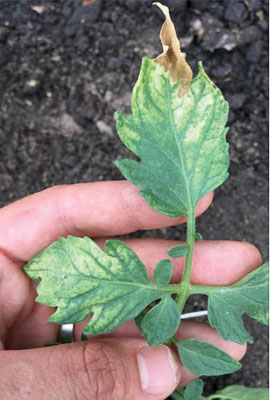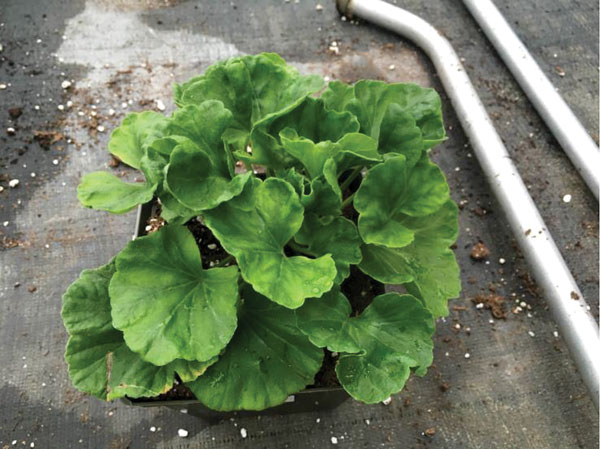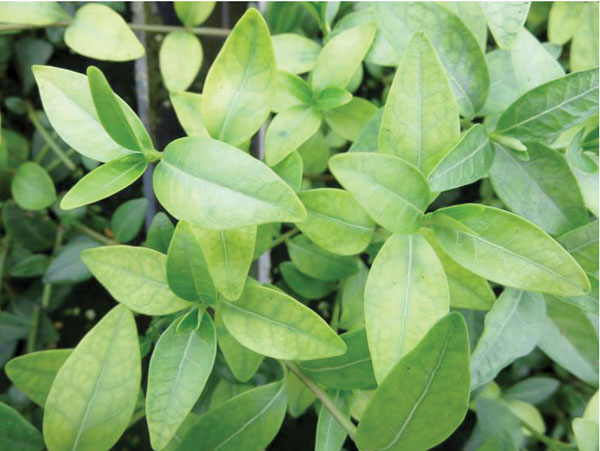3/1/2019
Avoiding Ammonium Toxicity
Ryan Dickson & Rosa E. Raudales

Fertilizing with high amounts of ammonium nitrogen during winter and early spring increases the risk of ammonium toxicity, especially in northern climates. Ammonium toxicity tends to be more problematic for northern growers because of lower light and temperatures, especially during winter and early spring. Southern growers typically have higher light and warmer temperatures throughout much of the year, and can often get away with applying more ammonium.
Symptoms of ammonium toxicity in mature plants often develop first on the lower older leaves, whereas symptoms in bedding plants and seedling plugs often develop first on the younger leaves.
Figure 1. Interveinal chlorosis and leaf tip burn (necrosis) caused by ammonium toxicity in tomato.
Symptoms typically start with interveinal leaf chlorosis (Figure 1). Leaf margins may curl upward or downward, depending on the plant species. Root growth is delayed, and advanced symptoms include leaf necrosis (brown, crispy tissue) and burning of roots.
Many water-soluble fertilizers formulations contain more than one form of nitrogen, where common nitrogen forms include ammonium (NH4), urea and nitrate (NO3). Ammonium and urea can result in ammonium toxicity under certain growing conditions. This article covers a grower scenario where ammonium toxicity occurred, as well as strategies to correct and prevent ammonium toxicity.
Ammonium toxicity: Grower scenario
The operation was located in a northern climate and the irrigation water source had high alkalinity at over 300 ppm bicarbonates. The high alkalinity was causing root zone pH to increase, which was creating nutritional problems, particularly micronutrient deficiency. The growers switched to an “acidic” reaction fertilizer that would push pH down in order to counteract the high alkalinity (increases pH) and keep a steady root zone pH. The acidic fertilizer had most of the nitrogen in the ammonium and urea form.
Figure 2. Interveinal chlorosis in geranium from high ammonium.
Changes t o the fertilizer program were made during the summer. Plants were healthy through early fall, but symptoms of ammonium toxicity started to develop in geranium (Figure 2) and vinca (Figure 3) during winter and early spring.
o the fertilizer program were made during the summer. Plants were healthy through early fall, but symptoms of ammonium toxicity started to develop in geranium (Figure 2) and vinca (Figure 3) during winter and early spring.
Why is too much ammonium toxic, but not nitrate?
Plants rapidly take up ammonium and use it for plant growth, but accumulation in the root zone and plant tissues can be toxic to plant cells. Plants cannot store ammonium, and must convert it to a non-toxic form and use it immediately for growth after uptake. Urea also can cause ammonium toxicity because urea is converted to ammonium either in the root substrate or after uptake. On the other hand, plants take up nitrate, and use it immediately for growth or store it in roots and shoots until needed.
Ammonium accumulates to toxic levels when applying ammonium-based fertilizers in combination with low light and cloudy conditions. Plants need energy from photosynthesis to incorporate nitrogen into growth, which can be limited under low light.
Ammonium toxicity also tends to occur under cooler temperatures. Warm temperatures promote the activity of nitrifying soil bacteria in the root substrate, which converts ammonium into nitrate, reducing ammonium and minimizing the risk of toxicity. However, microbial activity decreases as the temperature of the substrate drops, especially below 55F to 65F (12 to 18C).
What about our grower?
Our growing operation ran into ammonium toxicity after switching to an “acidic” fertilizer to counteract the high alkalinity in the irrigation water. Acidic fertilizers have higher amounts of ammonium and urea nitrogen (>40% of total N) because these nitrogen forms are what produce acid in the root zone and drop pH.
 Figure 3. Interveinal chlorosis in vinca from high ammonium. Photo courtesy of Leanne Pundt, University of Connecticut.
Figure 3. Interveinal chlorosis in vinca from high ammonium. Photo courtesy of Leanne Pundt, University of Connecticut.
On the other hand, “basic” reaction fertilizers have mostly nitrate nitrogen (>80% of total N) because nitrate produces basicity in the root zone that increases pH. Use of acidic fertilizers to counteract high water alkalinity can therefore increase the risk of ammonium toxicity, especially under low light and cooler conditions. Growers with high alkalinity may consider injecting mineral acid into the irrigation water as an alternative strategy to neutralize alkalinity.
To alleviate ammonium toxicity, the first step is to leach the root substrate to wash out the ammonium and then apply a nitrate-based (low ammonium) fertilizer to replenish the nutrient balance. Ammonium toxicity can appear similar to other nutritional and plant health problems, especially during early stages. For example, interveinal chlorosis of young leaves is a common symptom of micronutrient deficiency, and damaged roots look similar to Pythium and other root diseases. It’s important to rule out other potential factors when making a diagnosis.
For northern growers, a good strategy to prevent ammonium toxicity is to apply nitrate-based (low ammonium and urea) fertilizers between the months of November and March. Regularly checking the root zone pH and water alkalinity are good ways to monitor the fertilizer program and acid injectors, and detect nutritional problems before they result in crop loss. GT
Dr. Ryan Dickson (ryand@uark.edu) is an Assistant Professor in the Department of Horticulture at the University of Arkansas. Dr. Rosa Raudales (rosa.raudales@uconn.edu) is an Assistant Professor at the University of Connecticut.